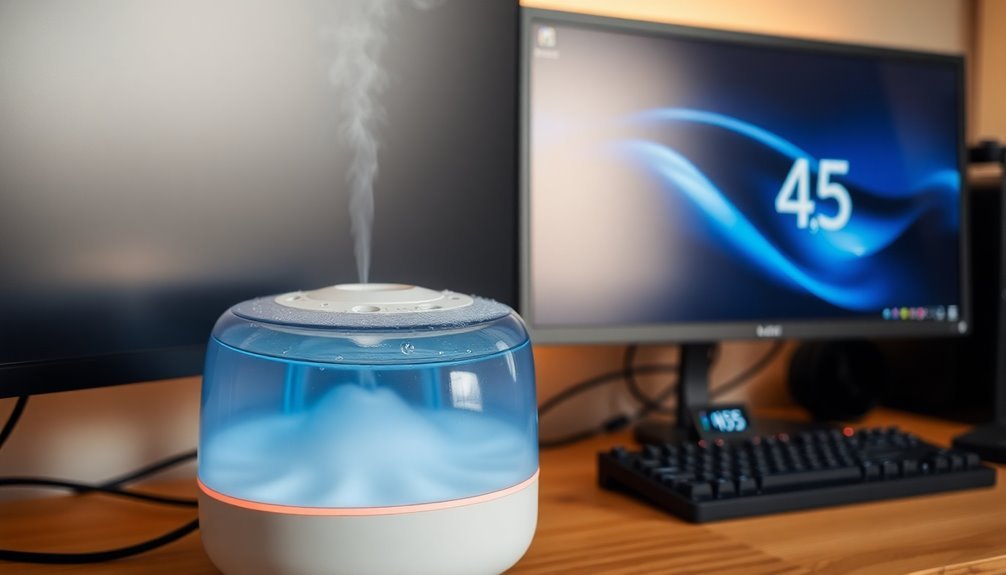The three most effective humidifiers for protecting your electronics from static damage are Direct Room Humidification Systems, Steam-Based Electronic Protection Units, and Dry Fog Anti-Static Solutions. Direct Room systems create micro-fine water droplets under 15 μm for even distribution, while Steam-Based units offer precise modulation control with dual actuators for reliability. Dry Fog solutions use ultra-fine 10 μm droplets that won't leave excess moisture on surfaces. You'll want to maintain humidity levels between 40-60% RH to prevent electrostatic discharge. Each system offers unique advantages that can transform how you safeguard your valuable electronic equipment.
Direct Room Humidification Systems

Precision in humidity control stands at the forefront of protecting sensitive electronics. When you're working with electronic components, maintaining humidity levels between 40% and 60% RH is essential for preventing electrostatic discharges that can damage your equipment.
Direct room humidification systems offer a targeted solution, as they're installed directly in your production area rather than through central HVAC systems. Friction between materials can quickly generate static electricity in dry environments.
These systems use high-pressure humidifiers that create micro-fine water droplets smaller than 15 μm, ensuring even distribution throughout your space. You'll find that the moisture forms a protective film on surfaces, naturally dissipating electric charges that could otherwise harm your electronics. The systems are particularly effective when placed near heat-generating machines, where dry air pockets commonly occur.
You'll need to maintain your system with multi-stage water treatment to remove bacteria, germs, and minerals. Digital controls help you monitor and adjust humidity levels precisely, while ceiling-mounted atomizing nozzles distribute moisture evenly.
The energy consumption is relatively low, and you'll benefit from improved product quality and reliability through consistent environmental conditions.
Steam-Based Electronic Protection Units
Building upon direct humidification methods, steam-based electronic protection units offer advanced control features for safeguarding your sensitive equipment. These UL-listed systems use sophisticated modulation control to manage steam, vacuum, or hot water actuators through voltage or current signals, maintaining precise humidity levels in your workspace. The ability to operate with two independent actuators provides enhanced control precision and redundancy.
You'll find these units particularly effective in electronics manufacturing environments where ESD and corrosion pose substantial risks. The dual operation modes support both parallel modulation and First-Open-First-Close logic, giving you flexible control options while reducing system stress.
Key advantages you'll get with steam-based protection units:
- Customizable valve settings for start position, delay, and close percentages, helping you minimize piping stress and noise.
- External setback capabilities with optional 4-20mA EMS interface for remote setpoint control.
- Compatibility with multiple sensor types and signal formats (0-10V, 0-5V, 2-10V, 1-5V, 4-20mA).
When you're protecting valuable electronic components, these units deliver consistent humidity control that markedly reduces ESD-related failures and corrosion risks. Their adaptability to various manufacturing environments makes them an ideal choice for maintaining superior production conditions.
Dry Fog Anti-Static Solutions

Maintaining ideal humidity levels in your electronics workspace becomes effortless with dry fog anti-static solutions. These systems utilize ultra-fine droplets with a mean diameter of 10 μm or less, providing superior static protection without wetting your valuable equipment.
You'll find two primary nozzle options: type 03B and 04E. The 03B nozzle delivers 3.3-13.2 ℓ/hr of fog with a 12 μm droplet size, while the 04E produces 3.0-12.0 ℓ/hr with a finer 10 μm droplet size.
You won't need to worry about excess moisture, as these droplets are markedly smaller than traditional dry mist systems. Installation requires no obstacles within 4 meters of the front side for optimal performance.
The benefits you'll experience are substantial. Your electronics manufacturing process will see reduced static-related damage and improved product quality.
You'll maintain a consistent 50% relative humidity level, which not only protects your equipment but also creates a healthier work environment.
Plus, you'll save on operating costs, as dry fog systems use just one-fifth of the energy compared to steam humidification alternatives.
For targeted application, you can use the chemical-resistant AKIMist "E" TN in specific areas where static protection is most critical.
Frequently Asked Questions
How Long Does It Take to See Results After Installing a Humidifier?
You'll notice initial effects within 10-30 minutes for small humidifiers and up to an hour for larger ones. However, it'll take 4-8 hours of running time to achieve ideal humidity levels in your space.
Can I Use Tap Water Instead of Distilled Water in Anti-Static Humidifiers?
You shouldn't use tap water in your humidifier. It'll create mineral buildup and white dust that can harm performance. Stick with distilled water to guarantee proper function and reduce maintenance needs.
Should Humidifiers Run Continuously or on a Timer for Electronic Protection?
You'll want to run your humidifier continuously rather than on a timer. It's essential for maintaining consistent humidity levels between 40-60%, which provides constant protection against static electricity and ESD damage.
What's the Average Lifespan of an Industrial Anti-Static Humidification System?
You'll typically get 15 years from a well-maintained industrial anti-static humidification system. With proper care and quality components, you can expect your adiabatic system to operate efficiently throughout this period.
Do Anti-Static Humidifiers Need to Be Grounded for Proper Static Protection?
Yes, you'll need to ground your anti-static humidifier for effective static protection. While humidity helps reduce static, proper grounding is essential to safely dissipate electrical charges and prevent electrostatic discharge in your environment.
In Summary
You'll find any of these three humidification solutions can effectively protect your sensitive electronics from static damage. Whether you choose direct room systems for whole-space coverage, steam units for targeted protection, or dry fog solutions for precision control, maintaining proper humidity levels prevents costly equipment failures. Select the option that best fits your space and budget to safeguard your valuable electronic investments.





Leave a Reply